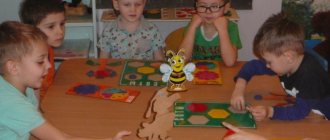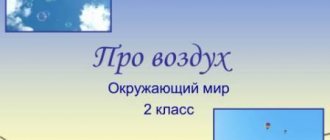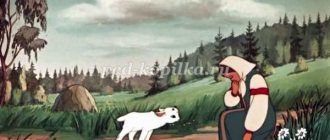Educational games by Voskobovich
The first games of Vyacheslav Voskobovich appeared in the early 90s. Basically, these are construction games and puzzles, accompanied by fairy-tale plots.
The most famous of them are “Geokont” and “Voskobovich Square”.
Games develop design abilities, spatial thinking, attention, memory, creative imagination, fine motor skills, the ability to compare, analyze and contrast. There are also more complex games that teach children to model and relate parts and the whole.
In such games, children comprehend theory through practice. The author has also created manuals aimed at learning numbers (for example, “The Magic Eight”) and letters (“Letter Constructor”), and for learning to read (for example, using the universal textbook “Folds”). Voskobovich's games are multifunctional and are intended for children from 2 to 10 years old (although they can be up to 99 years old).
A little history
Vyacheslav Vadimovich Voskobovich - lives in St. Petersburg. He has developed more than 40 educational games and manuals. In the past, Vyacheslav Vadimovich was an engineer-physicist.
The impetus for the invention of games came from two of his own children and “empty” toy stores during the era of Perestroika. Voskobovich, trying to find an alternative to the usual post-Soviet toys, came across the experience of Nikitin and Zaitsev, but decided to go his own way. This is how his first creative games appeared: “Geokont”, “Game Square”, “Color Clock”.
“We abandoned “disposable” products: assembled, disassembled and put aside, we create universal games that can be creatively used repeatedly,” says Vyacheslav Voskobovich.
A little later it was created for the development, production, implementation and distribution of methods and developmental and correctional games.
Goals of classes with Voskobovich game materials
• Development of the child's cognitive interest and research activity.
• Development of observation, imagination, memory, attention, thinking and creativity.
• Harmonious development of emotional-imaginative and logical principles in children.
• Formation of basic ideas about the surrounding world, mathematical concepts, sound-letter phenomena.
• Development of fine motor skills.
Features of Voskobovich's educational games
— The games are designed based on the interests of children.
By playing with such gaming aids, children get real pleasure and discover more and more new opportunities for themselves.
— Wide age range.
Children from 2 to 7 years old and older can play the same game.
The game begins with simple manipulation and then becomes more complex due to a large number of different game tasks and exercises.
— Multifunctionality and versatility.
By working with only one game aid, the child has the opportunity to show his creativity, develop comprehensively and master a large number of educational tasks (get to know numbers or letters, colors or shapes, counting, etc.).
— Ready-made educational didactic material, systematized by age and educational objectives.
— Methodological support.
Many games are accompanied by special methodological books with fairy tales, in which various plots are intertwined with intellectual tasks, questions and illustrations. Fairy tales and their good heroes - the wise raven Meter, the brave little Geo, the cunning but simple-minded Vse, the funny Magnolik - accompanying the child through the game, they teach him not only mathematics, reading, logic, but also human relationships.
Voskobovich's most popular games
“ Geokont ” - it is also called a “plate with nails” or “multi-colored cobwebs” -. It is a plywood board with a coordinate film applied to it. Plastic nails are attached to the playing field, onto which multi-colored “dynamic” elastic bands are pulled. As a result of this design, object silhouettes, geometric shapes, patterns, numbers, and letters are obtained.
The game set is accompanied by the methodological fairy tale “Little Geo, Raven Meter and Me, Uncle Slava” (the word “geometry” is encrypted in the title of the fairy tale).
And the fairy tale begins like this: “One day, little Geo had a dream. He walks around the world for a day, a second, a third, and suddenly he meets the Red Beast. The kid got scared, ran, and suddenly - a voice: “Don’t be afraid of the Red Beast, drive him away with an orange cry.” The baby shouted with an orange cry - the Red Beast disappeared, but a tree appeared, on the top of which the Yellow Bird sat. The Yellow Bird flapped its wings and circled, the Kid got scared and ran. And again the voice: “Don’t be afraid of the Yellow Bird - drive it away with a green whistle.” The baby whistled with a green whistle - the Yellow Bird disappeared. A lake appeared and a boat stood on the shore. The Kid got into the boat, made a few strokes, and suddenly a Blue Fish swims out. The Kid got scared again and leaned on the oars, but that was not the case. And again the voice: “Don’t be afraid of the Blue Fish, drive him away with a blue whisper.” The Kid whispered in a blue whisper - the lake disappeared, the boat disappeared. Geo stood in front of the entrance to the Violet Forest."
Thus, the baby does not just create images on Geokont, but makes the web of the Yuka spider, rays and segments, which are called the “orange cry of the Red Beast,” “the green whistle of the Yellow Bird,” or the “blue whisper of the Blue Fish.” The book contains diagrams and drawings of what a child should achieve.
As a result of playing with “Geokont”, children develop motor skills of the hand and fingers, sensory abilities (mastering color, shape, size), mental processes (designing according to a verbal model, constructing symmetrical and asymmetrical figures, searching for and establishing patterns), and creativity.
“Voskobovich Square” or “Game Square” can be 2-color (for children 2-5 years old) and 4-color (for 3-7 year old children)
The game consists of 32 rigid triangles, glued on both sides at a distance of 3-5 ml from each other on a flexible fabric base. On one side the “Square” is green and yellow, on the other – blue and red. The “square” is easily transformed: it can be folded along fold lines in different directions according to the “origami” principle to obtain three-dimensional and planar shapes. That is why this game is also called “Eternal Origami” or “Transformer Square”.
The game is accompanied by a methodological tale “The Mystery of the Raven Meter, or the tale of the amazing transformations and adventures of a square.” In it, “Square” comes to life and turns into various images: a house, a mouse, a hedgehog, a kitten, a boat, a shoe, an airplane, candy, etc. The child collects figures from pictures in a book that shows how to fold a square and gives an artistic depiction of the same object.
This square puzzle not only allows you to play, develop spatial imagination and fine motor skills, but is also a material that introduces the basics of geometry, steriometry, counting material, the basis for modeling, creativity, which has no age restrictions.
"Miracle Crosses" is a game with inserts. The inserts are made of circles and crosses. The crosses are cut into pieces in the form of geometric shapes. At the initial stage, children learn to assemble cut shapes into a single whole. Further, the task becomes more complicated: according to the diagrams in the “Album of Figures” (attached), the child first collects paths, towers, and then dragons, men, soldiers, insects and much more.
The game develops attention, memory, imagination, creativity, “sensory” (distinguishing the colors of the rainbow, geometric shapes, their size), the ability to “read” diagrams, compare and make a whole from parts.
“The “Splash-Splash ” is a playing field made of carpet in the form of a ship with a glued plywood hull and printed numbers from 1 to 7. To the mast on the hull you need to attach velcro flags - sails - in the colors of the rainbow and according to the required number. The game develops fine motor skills, attention, memory, thinking, gives an idea of mathematical concepts, color, height, spatial arrangement of objects, conventional measurement, number of objects, their serial number and digital series.
“Math Baskets” - this manual will help your child literally “touch” counting, understand the composition of numbers, and also understand the meaning of addition and subtraction. The baby needs to put a certain number of mushroom inserts into baskets with different numbers of recesses. According to the fairy tale, a child, together with the little animals: Hedgehog-One, Bunny-Two, Mouse-Three and others, collects mushrooms in baskets, counts them, distributes an equal number of mushrooms to the animals and checks who has full baskets and who doesn’t. The animals collect mushrooms, and the baby finds out who has collected more and who has collected less.
“Funny Letters” are cards with images of the vowels of the Russian alphabet in the form of acrobat jesters: the first jester curved like the letter A and his name is Harlequin, the other jester twisted like the letter O and his name is Orlekin, U appears to be Urlekin, there are also Jarlekin, Yrlekin, Yurlekin, etc. By playing with cards and singing the names of jesters, the child becomes familiar with letters and practices sound analysis of words; develops attention, memory, thinking, imagination and speech.
"Voskobovich's Teremki" is a unique tool for teaching reading on a visual basis. The game consists of 12 wooden chest cubes of different colors (2 white, 2 blue, 2 yellow, 2 purple, 2 brown) with consonant letters on the edges, as well as 12 cardboard chest cubes (2 blue, 2 green, 6 double blue -green, 2 symbolic) with vowels on the edges, which are put into tower cubes to form syllables. And from several “teremki” you can make a word.
At the first stage of the game, the child becomes familiar with sounds and letters. On the faces of the first white cube there are the letters B, P, V and F. The child turns the cube in different directions and names the sounds. Then he comes up with what animals could live in this little house: a butterfly, a parrot, a wolf, an eagle owl. In the same way, the child gets acquainted with the rest of the “teremkas”.
Now the insert cubes with jester vowels are connected. The blue cube contains A, O, U, E, Y (vowels showing the hardness of the sound), and the green cube contains I, Yo, Yu, I, E (vowels showing the softness of the vowel sound).
At the second stage, we learn to form syllables. We put a cube with the letter A into the first “terem” and read the resulting syllable: “Pa.”
At the third stage, you can compose and read simple words. The device of the tower cubes allows you to turn the process of learning to read into a series of exciting games. For example, a game of “transformers”, where “house” can easily become “smoke”, and “ice” into “honey”.
"Foldings"
. Voskobovich reworked the idea of Zaitsev's warehouses, who created cubes with warehouses.
The game-aid “Skladushki” is intended for teaching children to read in a storage system.
The manual is made in the form of a book, on each page there is a bright picture and a poetic caption with highlighted sections. There is also a CD with voiced warehouse songs, for example, one of them:
Goose and goose There were only a dozen goslings. The goose and the goose were shortchanged. Everyone was there.
What you should pay attention to when working with your child on Voskobovich’s games:
• Preparation. Before offering the game to your child, read the guidelines and the game itself.
• Speech. Mostly children work with their hands and speak little. During classes, ask your child what he is doing, why he chose this particular figure and not another, ask him to retell the fairy tale task or come up with his own plot.
• Static. When engaging with play materials, the child is most often in the same sitting position. It is necessary to take into account the age characteristics of children and promptly distract them from sitting for too long.
• Perseverance. Playing with Voskobovich's manuals requires perseverance, and not every child likes or is able to do this.
Author-compiler: Daria Koldina
Author of the method
V.V. Voskobovich, a physicist and mathematician by training, discovered his talent as a teacher and methodologist in the early 90s. During a period of shortages in stores, with modest financial resources, he raised two sons. Their development required the manifestation of imagination. Voskobovich's first games were created based on the works of Zaitsev and Nikitin.
A sweet hobby eventually turned into a lifelong endeavor. Within a few years he founded the methodical. The author actively conducts seminars on the implementation of his own methodology in the educational process, develops and distributes new games (today there are more than 50 variations). Voskobovich calls his games for preschoolers technology or “Fairytale labyrinths of games.” Having become an innovative teacher, he made a tangible contribution to the methodological collection of pedagogy during the crisis.






